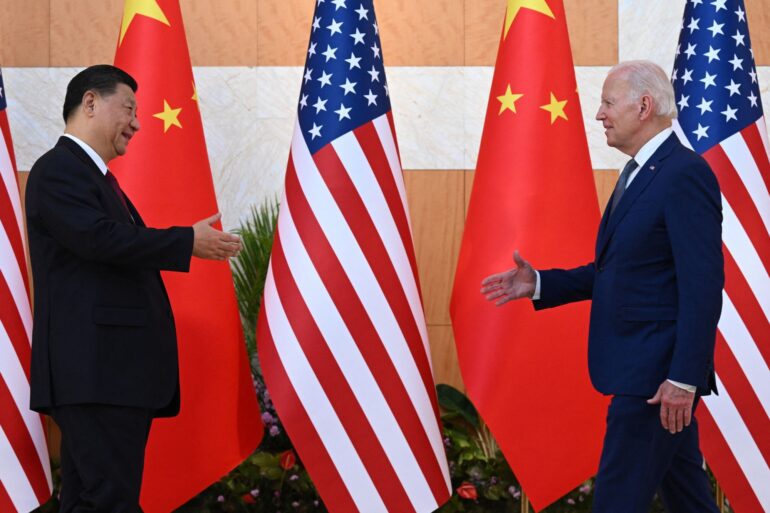TL;DR:
- Biden and Xi Jinping to discuss key global issues, including the Israel-Hamas conflict and Russian activities in Ukraine, in the San Francisco Bay Area.
- APEC summit backdrop for US-China talks on implementing AI in the military, focusing on reducing risks of unregulated AI usage.
- State Department officials emphasize the importance of mitigating AI-related risks to prevent unintended military escalations.
- Biden-Xi meeting is potentially a stepping stone for deeper military dialogue and arms control discussions.
- US leading global effort for responsible military AI use; 30 nations initially supporting an agreement, now joined by 45 at the UN.
- Declaration promotes AI development in line with humanitarian principles, emphasizing reliability and reducing bias.
- Need for US-China consensus on defining AI weapons amidst global AI advancement race.
- Possibility of shared benefits in AI risk management as a basis for US-China cooperation in technology and military strategy.
- The recent resumption of US-China military talks following geopolitical tensions highlights the importance of sustained dialogue.
Main AI News:
As US President Joe Biden prepares for his pivotal encounter with Chinese leader Xi Jinping in the heart of the San Francisco Bay Area, the agenda brims with critical topics, not least the Israel-Hamas conflict and the ongoing Russian military activities in Ukraine. At the backdrop of the APEC summit, US delegates are keenly pursuing discussions with China about establishing frameworks for the military application of artificial intelligence, aiming to mitigate the hazards posed by its hasty and unregulated usage. A high-ranking State Department official, requesting anonymity, highlighted the shared responsibility to diminish AI-related risks, particularly those leading to inadvertent escalations.
This significant meeting between Biden and Xi is seen as a catalyst for intensified military dialogue. According to the State Department representative, the meeting’s positive outcomes could pave the way for further discussions on bilateral arms control and non-proliferation. The United States is at the forefront of forming a global consensus on AI in military use. Vice President Kamala Harris recently announced an accord endorsed by 30 countries, stressing AI development adhering to international humanitarian principles, enhancing reliability, transparency, and minimizing bias.
The US is encouraging more countries to join this military AI pact, set to be officially initiated at the United Nations, now with 45 nation signatories. Sasha Baker, acting undersecretary of defense for policy, remarked that this declaration fosters global norms for responsible AI use in the military, fostering common understanding and sharing best practices among states. Both the US and China, along with the European Union, are actively shaping AI regulations. Despite the global race to advance AI technology, there’s an urgent need for the US and China to reach a consensus on defining AI-based weapons, as noted by expert Triolo.
Andrew Reddie, a public policy research professor at UC Berkeley, suggests that mutual benefits in AI risk management could bridge the trust gap between the US and China. A potential symbolic agreement on AI use in military applications might emerge from the APEC summit, although Reddie expects it to be non-binding due to the significant differences between the two nations.
Even with a ban on lethal autonomous weapons, uncontrolled AI use could disrupt military operations, as seen in Ukraine’s conflict with autonomous drones. The recent resumption of US-China military talks, previously stalled due to geopolitical tensions, underscores the necessity for dialogue, especially given the recent incidents in the South China Sea involving close encounters between military assets of both countries.
Rogier Creemers, a Chinese technology policy scholar at Leiden University, cautions against the complexities and risks AI systems introduce in such situations. Meanwhile, China has indicated a readiness to reengage in dialogue, with statements from the Xiangshan Forum expressing a willingness to develop military ties with the US based on mutual respect and cooperation.
Conclusion:
The ongoing dialogues between the US and China regarding the use of AI in military applications are indicative of a larger trend towards the regulation and ethical use of emerging technologies on a global scale. For the market, this trend could signal a shift towards increased collaboration and standard-setting in the field of AI, potentially leading to more stable and predictable market conditions. The focus on reducing risks and adhering to international humanitarian principles in AI development may also spur innovation in AI safety and reliability, opening up new market opportunities. Furthermore, the push for a clear definition and agreement on AI-based weaponry underscores the importance of policy clarity for businesses operating in or adjacent to defense and AI sectors, which can influence investment and development strategies.

